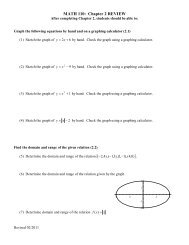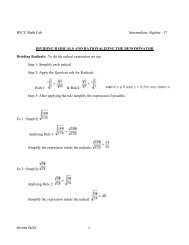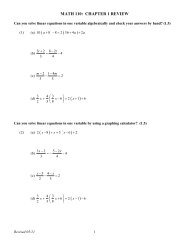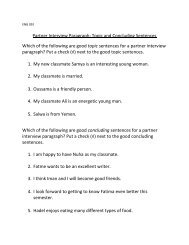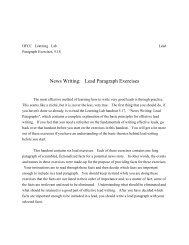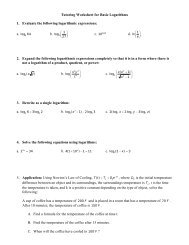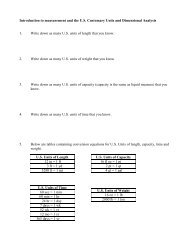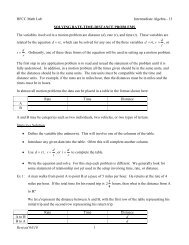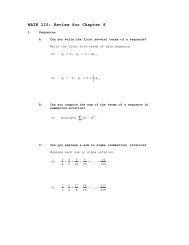Factoring ax^2+bx+c, a is not 1 - The Learning Lab at HFCC
Factoring ax^2+bx+c, a is not 1 - The Learning Lab at HFCC
Factoring ax^2+bx+c, a is not 1 - The Learning Lab at HFCC
Create successful ePaper yourself
Turn your PDF publications into a flip-book with our unique Google optimized e-Paper software.
Step 1: Find the product: ac = ( 6)( 10)= 60Step 2: Find m, n where m • n = 60 and m + n = − 19 , herem = − 4, n = − 15Step 3: Rewrite the trinomial using the two integers from step 2 to break up themiddle term.26x− 19x+ 102= 6x − 4x − 15x+ 10 Split the middle termStep 4: 2x( 3x 2) 5( 3x2)= − − − Factor the GCF from the first two terms andStep 5: ( 3x2)( 2x5)Factor the GCF from the second two terms= − − Factor out the resulting common binomialfactor ( 3x − 2)ANSWER:26x19x10− + ( 3x2)( 2x5)= − − .25) Factor 11x+ 4 − 3xcompletely:2Before you start rewrite 11x+ 4 − 3xin descending order − + +23x11x4FIRST: check for a COMMON FACTOR among the coefficients or thevariables. In th<strong>is</strong> case the COMMON FACTOR = − 1 ; <strong>Factoring</strong> out2−1 3x−11x− 4th<strong>is</strong> factor we get: ( )2We will now use the procedure given above to factor 3x−11x− 4 . Generally it <strong>is</strong>easier to factor a trinomial if the leading coefficient a <strong>is</strong> positiveWe must remember to include the factor ( − 1) in our final answer.NOTE: a = + 3, b = − 11, and c = − 4Step 1: Find the product: ac = ( − 3)( 4)= − 12 andStep 2: Find m, n where m • n = − 12 and m + n = − 11 , herem = − 12 and n = + 1Step 3: Rewrite the trinomial using the two integers from step 2 to break up themiddle term.23x−11x− 4Rev<strong>is</strong>ed 03/09 4




